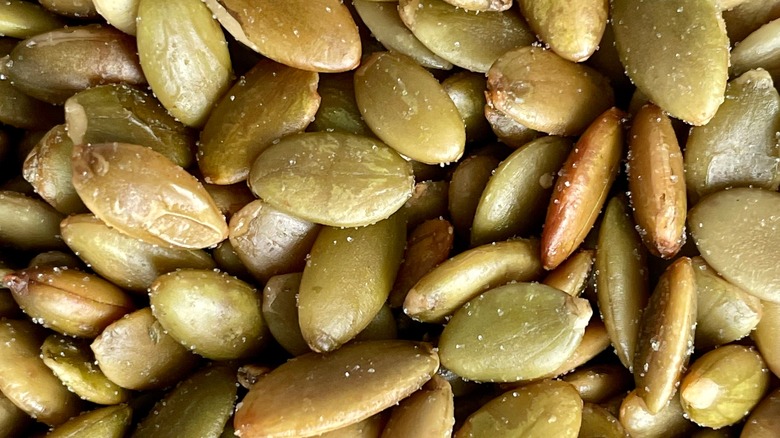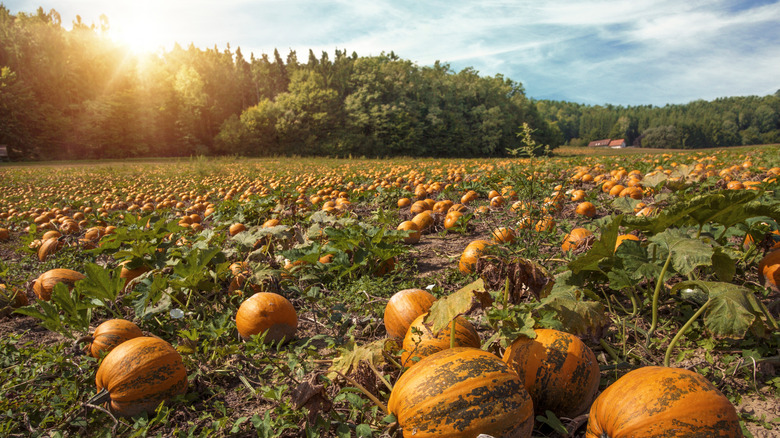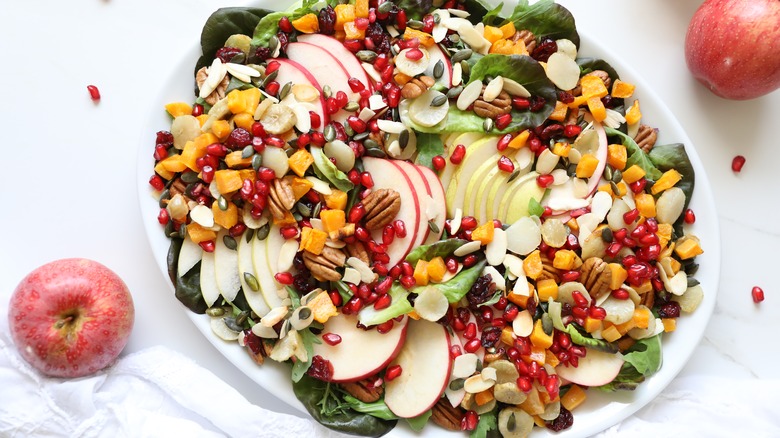Pumpkin Seeds Vs. Pepitas: The Subtle Difference
Pumpkins are a natural gift that keeps on giving. You can carve them into decorations, eat the nutrient-dense flesh (though that's not recommended if you've already made a jack-o'-lantern), and snack on the abundant seeds.
Pumpkin seeds are more than just a byproduct of a Halloween pumpkin-carving night. They're a perfect high-energy snack, trail mix ingredient, salad topper, or nut butter mix-in. The flat, tear-shaped green pumpkin seeds are sold pre-packaged or in bulk, often without their whitish shells. But did you know you can actually eat those shells?
Healthline reports that this crunchy, protective hull increases the amount of fiber you ingest when chowing down on the wholesome seeds and bumps up the concentration of minerals, including zinc, iron, copper, and magnesium. However, the rigid shells may cause digestive issues, particularly in people with gastrointestinal conditions, Healthline adds. Fortunately, there's the friendly pepita to squash some of your concerns.
What are pepitas?
Pepitas are a type of pumpkin seed that has never had a shell in the first place. They come from varieties of the cucurbit known as hulless, or Styrian, pumpkins.
According to Specialty Produce, these were a naturally occuring mutation of the field pumpkin discovered in Austria in 1934, yielding seeds that did not form the hard outer shell. Because the seeds didn't need to be hulled, they became (and remain) quite valuable for pumpkin seed oil production, hence the alternative name of oil seed pumpkins. And, of course, they're beloved for their culinary qualities.
While Specialty Produce explains that Styrian pumpkins are native to Austria, where they were first found, pepitas have since become popular in Mexican cuisine. Isabel Eats writes that pepita means "little seeds of squash." They're used to make oil, thicken and season salsas and pestos, and as garnishes and nut substitutes. Mexico News Daily adds that moles (sauces) prepared with pepitas are called pipián. They begin with roasting the seeds, grinding them, and adding them into the mixture that you're cooking.
Where to buy pepitas
You can find pepitas at many Latin grocery stores, at specialty food stores, or online. Pepitas are light to dark green in color and a bit plumper, rounder, and more oily than other pumpkin seeds. If you want to grow them yourself, browse the websites of seed companies for Styrian or Styrian hulless pumpkin seeds.
According to Heritage Harvest Seed, the pumpkins are attractively striped with orange and green, and the hardy vines can grow fruits that are up to 20 pounds. And per Gardening Know How, pumpkin seeds won't sprout if the soil's too cold, so plant them after all frosts have passed and the ground is at least 65 degrees Fahrenheit.
Aside from devouring them by the handful, there are many delicious ways to eat pepitas. Use pepitas in place of pine nuts in a pumpkin seed pesto recipe or an avocado-based pumpkin seed dip. Toss them on top hearty pumpkin and pumpkin seed maccheroncini, or dessert-ify them in cranberry pumpkin seed scones. You can even use them to craft a healthy crust for meats and fish. Pepitas are more versatile than you think, so let this chance botanical mutation become the hero of your next culinary adventure.


